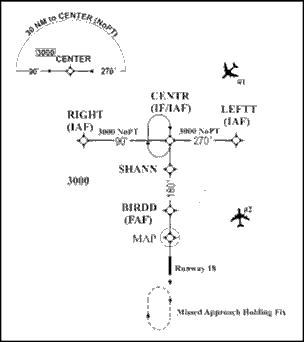yup
Trusted Contributor
- Messages
- 196
When am I allowed to clear an aircraft for an RNAV approach? For this question I don't want to give them vectors, I want them to fly the procedure on their own.
Let's look 4–8–4 Approach Clearance Procedures. According to subpara (a)5 I can clear them for the approach if I send them to a fix at least 3NM outside the FAF at an intercept angle of no more than 30 degrees. Okay.
But say they're inbound at a greater angle than that. Paragraph (d) says I can clear them for the approach if they're direct to the IAF as long as a procedure turn, hold-in-lieu, or arrival holding pattern is depicted and the pilot will execute the procedure. Great!
Oh, but look at paragraph (h) with its RNAV APPLICATION banner. Subpara (h)1 says they have to have no more than a 90º intercept to the FAF before I can clear them. So… I should give them direct the FAF, tell them to "advise inbound," and withhold the approach clearance until then. Seems strange, but RNAV approaches aren't based on approach aids from the ground so they might be more restrictive (like when you're vectoring for an approach, the exceptions allowing intercepts within two miles of the gate don't apply to RNAV approaches). I can live with that.
But wait! There's more! Look at the example at the bottom of the paragraph. The first example below figure 4–8–4 shows Aircraft #2 being cleared direct CENTR, maintain at or above, cleared approach despite the greater-than-90º intercept! They explain that Aircraft #2 will execute the hold-in-lieu so it's okay. I would buy that explanation except that subpara (h)1 doesn't say anything about it being kosher if there's a hold, it says you have to have no more than 90º, full stop.
So what gives?
Let's look 4–8–4 Approach Clearance Procedures. According to subpara (a)5 I can clear them for the approach if I send them to a fix at least 3NM outside the FAF at an intercept angle of no more than 30 degrees. Okay.
But say they're inbound at a greater angle than that. Paragraph (d) says I can clear them for the approach if they're direct to the IAF as long as a procedure turn, hold-in-lieu, or arrival holding pattern is depicted and the pilot will execute the procedure. Great!
Oh, but look at paragraph (h) with its RNAV APPLICATION banner. Subpara (h)1 says they have to have no more than a 90º intercept to the FAF before I can clear them. So… I should give them direct the FAF, tell them to "advise inbound," and withhold the approach clearance until then. Seems strange, but RNAV approaches aren't based on approach aids from the ground so they might be more restrictive (like when you're vectoring for an approach, the exceptions allowing intercepts within two miles of the gate don't apply to RNAV approaches). I can live with that.
But wait! There's more! Look at the example at the bottom of the paragraph. The first example below figure 4–8–4 shows Aircraft #2 being cleared direct CENTR, maintain at or above, cleared approach despite the greater-than-90º intercept! They explain that Aircraft #2 will execute the hold-in-lieu so it's okay. I would buy that explanation except that subpara (h)1 doesn't say anything about it being kosher if there's a hold, it says you have to have no more than 90º, full stop.
So what gives?
